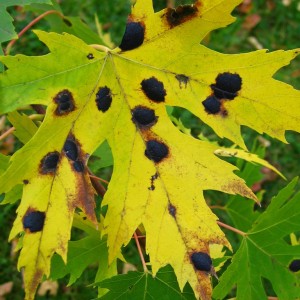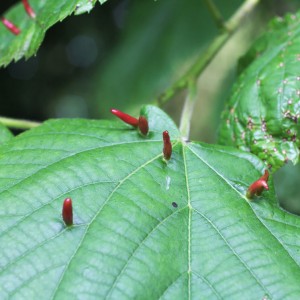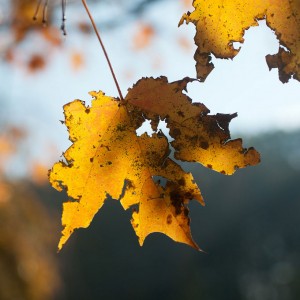Summer is hard on the “complexions” of trees, too

Tar spot on maple leaf. Photo: greenhem, Creative Commons, some rights reserved
As an arborist I am very mindful of complexion. Bruises and blemishes catch my eye, in addition to scabs, cuts, and even those out-of-place whiskers that appear out of nowhere. It sounds like a description of my aging skin, but I’m talking about the blotches, warts, and cuts that accumulate on tree leaves over the summer.
I suppose if we had to stand outside day and night all season, our skin would develop issues too. Those who work or play much outdoors need to be concerned about skin spots that show up suddenly. In the case of tree leaves however, that’s not the case—even the ugliest “skin” condition is generally no cause for concern.
One of the more alarming leaf disorders is called tar spot, whose symptoms are black blobs that often show up in late summer or early fall. Tar spot affects Norway, silver, red and sugar maples, in order of severity. The spots, which really do look like drips of roofing tar, seem to appear overnight, and sometimes cover much of the leaf. While it may look like a serious affliction, it’s really just a cosmetic issue. If you’re good with cosmetics you can probably make your tree look pretty again.

Eriophyes tiliae gall. Photo: stanze, Creative Commons, some rights reserved
Unlike the tar sands of northern Alberta in Canada, though, tar spots cannot be processed into crude oil. As disappointing as that may be, at least tar spot is not a problem. Spots are caused by several different species of fungi in the genus Rhytisma, which I mention because some of you play Scrabble.
If your tree’s leaves have sprouted tiny spindle-shaped structures that make it appear that the leaves need a shave, don’t worry. These are tiny galls, formed when a minute arachnid called an eriophyid (go for a triple score on that word) mite laid an egg, along with a dose of a plant hormone which directed the leaf to grow a little home for her young one.
Depending on the species of mite, these galls can be green, yellow, red, or pink. Some are squat and thick, resembling a wart, but they are all completely harmless. This is a good thing because galls shield the mites from anything you could spray on them anyway.

Scab on lime leaves. Photo: Scot Nelson, Creative Commons, some rights reserved
Believe it or not, scabs are caused by a disease called scab. I think it was late on a Friday when scab and tar spot were named, probably by a new intern who was later reprimanded for “making sense.” It affects apple, crabapple, hawthorn, juneberry, and other trees in the rose family. Scab causes affected leaves to drop early, and is much worse in wet seasons when it can defoliate a tree by mid-summer.
It’s a serious problem for orchardists because it causes scab-like blemishes on fruit in addition to weakening the tree, so they routinely spray fungicides beginning at bud break. Other ways of managing scab include proper pruning, increased airflow and access to sun, and buying scab-resistant varieties.

Tattered maple leaf. Photo: Wendy, Creative Commons, some rights reserved
High winds, especially early-season events, can tatter leaves, a condition called “leaf tatter.” (Same intern, don’t you think?) Japanese beetles, caterpillars, sawflies, and other insects chew on leaves over the summer, and leaf-cutter bees remove perfectly scribed circles. All in all, many trees look bedraggled by September. Should you be worried?
Here’s a secret: by late summer, trees don’t “need” their leaves any more. While this is true, it’s akin to saying you don’t need another five bucks at the end of the year. It would be nice, but it’s not going to change the big picture. A deciduous tree expends a huge amount of energy investing in new leaves each spring, and its leaves have to make enough sugar from sunlight to “repay” the tree, plus a little extra for rainy days. By early August, trees have recouped their investment along with a pile of interest.
Late-season disorders are superficial and no cause for concern. But if you are embarrassed by your tree’s appearance come late summer, you can always try cosmetics.
Paul Hetzler is a horticulture and natural resources educator with Cornell Cooperative Extension of St. Lawrence County.








I’m fascinated by the butternut trees which are just about the last to leaf out in spring, and have started earnestly losing their leaves by the last week of August. How do they get their work done with a schedule like that? It’s comparable to one of my neighbors who seems to sleep 16 hours a day.
It is impressive, for sure. Trees at high altitudes have it especially hard, as they may have to “git ‘er done” 20-30 days faster than the same species in the valleys.